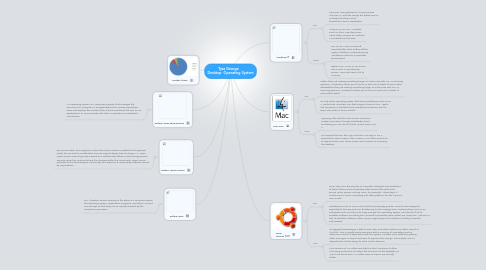
1. Market Share
2. Define: Operating System
2.1. An Operating System is a computer program that manages the resources of a computer. It accepts keyboard or mouse inputs from users and displays the results of the actions and allows the user to run applications, or communicate with other computers via networked connections.
3. Define: Open Source
3.1. pen source refers to a program in which the source code is available to the general public for use and/or modification from its original design free of charge, i.e., open. Open source code is typically created as a collaborative effort in which programmers improve upon the code and share the changes within the community. Open source sprouted in the technological community as a response to proprietary software owned by corporations.
4. Define: Ram
4.1. RAM (random access memory) is the place in a computer where the operating system, application programs, and data in current use are kept so that they can be quickly reached by the computer's processor.
5. Windows 8
5.1. Pro
5.1.1. Common User Experience Across Devices The new UI Will help merge the tablet and PC Markets and allow PCs to benefit from touch capabilities
5.1.2. WINDOWS TO GO- Windows 8 will run from USB drive even When older versions of Windows Are installed on the host
5.2. Cons
5.2.1. NO START MENU-Microsoft Has pulled the Start button off the Legacy interface, complicating any Windows 8 rollout in a corporate Environment.
5.2.2. NEED FOR MASSIVE TRAINING This is such a revolutionary version, users will need a lot of training.
6. Mac OSX
6.1. Pro
6.1.1. Rather than just making something larger, as is the case with OS X's zooming gestures, Windows 8 allows you to focus or pull out on levels of information detailRather than just making something larger, as is the case with OS X's zooming gestures, Windows 8 allows you to focus or pull out on levels of information detail
6.1.2. he only other operating system that does something similar is OS X, particularly Mountain Lion that brings it closer to iOS. Apple has long been in the tablet and smartphone business and has been successful in terms of both
6.2. Con
6.2.1. Opening a file with the Start Screen involves a couple more steps, though admittedly, it isn’t something you can do at all with Launch Pad in OS X.
6.2.2. To compare the two, the App Launcher is an app in OS X, whereas the Start Screen in the Modern UI is at the same time an app launcher, your home screen and a means of accessing the desktop,
7. Linux Ubuntu 12.0
7.1. Pro
7.1.1. Linux, was once the play toy of computer hobbyists and workhorse of behind-the-scenes computing tasks (most of the internet is served up by servers running Linux, for example). These days, it has become a home computing and office platform for the common user as well.
7.1.2. Distributions such as Linux Mint and the increasingly popular Ubuntu were designed especially to be easy and non-threatening for the average user. Implementing Linux on an enterprise level can add up to huge savings: the operating system, and almost all of its available software (including the Microsoft-compatible Libre Office) are 100% free. (There’s no lack of available software, either–as you might expect of a platform built by computer enthusiasts!)
7.2. Con
7.2.1. Its biggest disadvantage is that its end-users and office workers are often scared of it at first. This is usually easily overcome with a morning of orientation and an afternoon’s worth of experience with the system. Perhaps more difficult is getting other managers or board members to approve the change. Fortunately, most IT departments will be happy to back up the decision!
7.2.2. inux versions of MS Office emulate the later functions of Office (including post 2007) but retain the look but not the flexibility of, Word and Excel 2003. MS Office 2002 and prior are actually better
